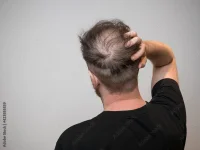
Anabolic steroids can significantly enhance muscle growth and performance, but they come with potential side effects, one of the most concerning for many users being hair loss. While not everyone is affected, those genetically predisposed to male pattern baldness (androgenetic alopecia) may find that steroids accelerate the process. Here’s a guide to understanding the link between steroids and hair loss, and how to minimize the damage.
Why Steroids Cause Hair Loss
Steroids like testosterone and its derivatives (e.g., Dianabol, Trenbolone, Winstrol) increase the level of dihydrotestosterone (DHT) in the body. DHT is a potent androgen that binds to receptors in hair follicles, shrinking them over time and leading to thinning or hair loss.
If you’re prone to androgenetic alopecia, steroids can speed up this natural process. However, the degree of hair loss varies depending on factors like:
- The type of steroid used.
- Dosage and duration of use.
- Individual genetic predisposition.
Steroids with Higher Risk of Hair Loss
Some steroids are more likely to contribute to hair loss due to their high androgenic activity, such as:
-Winstrol (Stanozolol)
-Anadrol
-Trenbolone
- Masteron
- Dianabol
In contrast, steroids like Deca-Durabolin (Nandrolone) and Anavar (Oxandrolone) are considered less androgenic and may pose a lower risk for hair loss.
How to Minimize Steroid-Related Hair Loss
1. Use Hair-Safe Steroids
Opt for compounds with lower androgenic effects, such as:
- Anavar
- Primobolan
- Deca-Durabolin
2. Incorporate DHT Blockers
Medications like “finasteride” or “dutasteride” can reduce DHT levels in the scalp, slowing hair loss. However, these drugs can have side effects, including reduced libido, so consult with a doctor before use.
3. Consider Topical Treatments
-Minoxidil (Rogaine): Improves blood flow to hair follicles, promoting growth.
-Ketoconazole Shampoo: Contains antifungal and anti-androgenic properties to combat hair loss.
4. Stay on Top of Nutrition
A healthy diet rich in vitamins and minerals like biotin, zinc, and vitamin D supports hair health. Supplements like collagen and omega-3 fatty acids may also strengthen hair.
5. Keep Dosages Low and Cycles Short
The higher the dose and longer the cycle, the more likely hair loss is to occur. Moderation can help minimize risks.
6. Avoid Harsh Hair Treatments
Steroids can make hair more brittle. Avoid excessive heat styling, chemical treatments, or tight hairstyles that strain the hair.
7. Explore Hair Restoration Options
For those who experience significant hair loss, options like PRP (Platelet-Rich Plasma) therapy or hair transplants can restore lost density.
CONCLUSION
Hair loss caused by steroids is a common concern, but understanding the risks and taking preventive measures can help minimize damage. If you’re predisposed to androgenetic alopecia, opt for milder steroids, consider protective treatments like DHT blockers, and maintain a balanced
lifestyle to support overall hair health.









